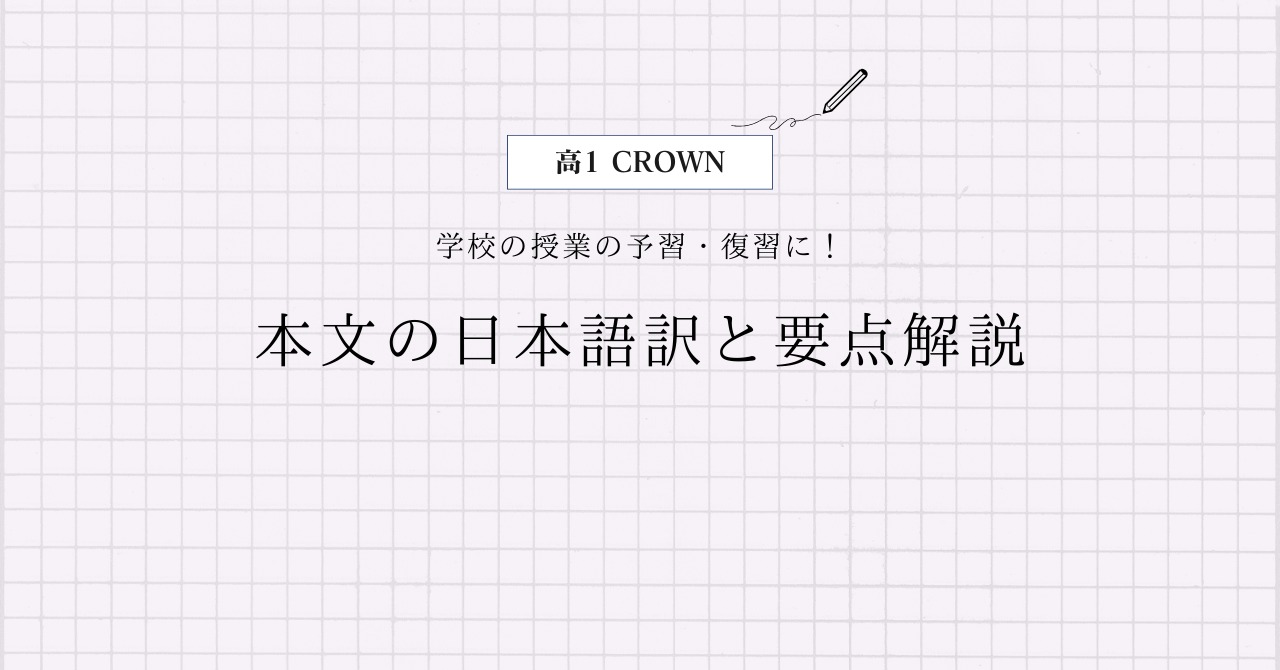三省堂 高1CROWN English Communication1 Lesson3 Section2の本文の日本語訳と重要箇所の解説です。
Section3-1, 3-3, 3-4の解説はこちらからご覧ください。
>高1CROWN English Communication1 Lesson3 Section1 本文和訳
>高1CROWN English Communication1 Lesson3 Section3 本文和訳
>高1CROWN English Communication1 Lesson3 Section4 本文和訳
- CROWN English Communication1 Lesson3 Section2 本文と日本語訳
- CROWN English Communication1 Lesson3 Section2 重要事項の解説
- In London, I happened to watch a TV program about a school for orphans and street children in Nairobi, Kenya.
- The children looked unhappy.
- I suddenly felt an urge to go to Kenya and paint something for those children.
- It wasn’t easy, but finally in 2006, I got to Kenya, found the school, and was able to paint for the children.
- I painted an angry dragon.
- I was happy with it, but a teacher complained,
- “The children are frightened by the dragon. Some of them refuse to come to school.”
- The children thought that it was a big snake.
- They did not know that dragons are imaginary.
- I asked them, “What would you like me to paint?”
- I asked the children to help me, and we had a lot of fun painting together.
- According to the teachers, the children became more active than before.
- That was a turning point in my career.
- Creating happiness through painting in collaboration with others is my thing.
- I made up my mind to do a painting project every year in different parts of the world.
- CROWN English Communication1 Lesson3 Section2 まとめ
CROWN English Communication1 Lesson3 Section2 本文と日本語訳
In London, I happened to watch a TV program about a school for orphans and street children in Nairobi, Kenya.
「ロンドンで,私はケニアのナイロビにいる孤児とストリートチルドレンのための学校に関するテレビ番組を偶然見ました。」
The children looked unhappy.
「その子どもたちは悲しそうでした。」
I suddenly felt an urge to go to Kenya and paint something for those children.
「私は突然ケニアに行って,その子どもたちのために何か描きたいという衝動に駆られました。」
It wasn’t easy, but finally in 2006, I got to Kenya, found the school, and was able to paint for the children.
「それは簡単なことではありませんでしたが,ついに2006年に,私はケニアに着き,学校を見つけて,子どもたちのために絵を描くができました。」
I painted an angry dragon.
「私は怒った竜を描きました。」
I was happy with it, but a teacher complained,
「私はそれに満足しましたが,ある先生が苦情を言いました。」
“The children are frightened by the dragon. Some of them refuse to come to school.”
『子どもたちは竜を怖がっています。学校に来るのを嫌がる子もいます。』
The children thought that it was a big snake.
「子どもたちは竜を大きな蛇だと思いました。」
They did not know that dragons are imaginary.
「彼らは竜が空想上のものだと知りませんでした。」
I asked them, “What would you like me to paint?”
「私は彼らに『何を描いてほしい?』と尋ねました。」
“Lions!” “Baobabs!”
『ライオン!バオバブ!』
I asked the children to help me, and we had a lot of fun painting together.
「私は子どもたちに手伝うよう頼み,私たちは一緒に絵を描くのをとても楽しみました。」
According to the teachers, the children became more active than before.
「先生たちによると,子どもたちは以前よりも活発になったそうです。」
That was a turning point in my career.
「そのことは私のキャリアの転換点になりました。」
Creating happiness through painting in collaboration with others is my thing.
「他者と協力して絵を描くことを通じて幸せを創ることが私の好きなことです。」
I made up my mind to do a painting project every year in different parts of the world.
「私は世界の様々な場所で毎年絵を描くプロジェクトをしようと決心しました。」

CROWN English Communication1 Lesson3 Section2 重要事項の解説
In London, I happened to watch a TV program about a school for orphans and street children in Nairobi, Kenya.
“happen to 動詞の原形“は「偶然~する」という重要表現です。
“orphan“は「孤児」という名詞になります。
The children looked unhappy.
“look 形容詞”は「~に見える」という重要表現で,“unhappy”は「不幸な,悲しい」という形容詞です。
I suddenly felt an urge to go to Kenya and paint something for those children.
“suddenly“は「突然に」という副詞です。
“felt”は“feel(感じる)”の過去形で,“urge”は「衝動,本能」という名詞になります。今回は「衝動に駆られた」と訳しました。
“to”は“go”と“paint”の両方にかかっていて,「不定詞の形容詞的用法」となり“an urge”を修飾しています。
“something”は「何か」という代名詞で,“those”は「あれらの,それらの」といった形容詞になります。
It wasn’t easy, but finally in 2006, I got to Kenya, found the school, and was able to paint for the children.
“It”は直前の文全体を指しています。
“finally”は「最終的に,ついに」といった副詞ですね。
“get to~”は「~に着く」,“found”は“find(を見つける)”の過去形,“be able to 動詞の原形”は「~することができる」という助動詞“can”と同じ意味になります。
I painted an angry dragon.
“angry”は「怒った」という形容詞で,“dragon”は「竜」という名詞です。
I was happy with it, but a teacher complained,
“be happy with~”は「~に満足する,~を喜んでいる」という表現で,“it”は“an angry dragon”を指していますね。
“complain”は「不満を言う,苦情を言う」という動詞です。
“The children are frightened by the dragon. Some of them refuse to come to school.”
“frighten”は「を怖がらせる」という動詞で,ここでは「受動態」になっているので,「怖がる」という意味になります。
“some of~”は「~のいくつか,~もいる」くらいで訳せばOKです。
“them”は“The children”指していて,“refuse”は「を嫌がる,拒む」という動詞です。
「~するのを拒む」と言う場合は,必ず“refuse”の後ろが「不定詞の名詞的用法」になります。「動名詞」にはできないので要注意です!
The children thought that it was a big snake.
“thought”の後ろには「接続詞that」が使われていますね。
“it”は“the dragon”を指していて,“snake”は「蛇」という名詞です。
They did not know that dragons are imaginary.
“They”は“The children”を指しています。
“know”の後ろには「接続詞that」が使われていますね。
“imaginary”は「想像上の,空想上の」という形容詞になります。
I asked them, “What would you like me to paint?”
“ask”は「に尋ねる」という動詞で,“them”は“The children”を指しています。
“would like 人 to 動詞の原形”で「人に~してほしい」という重要表現です。“want 人 to 動詞の原形”と同じ表現ですね。
I asked the children to help me, and we had a lot of fun painting together.
“ask 人 to 動詞の原形”で「人に~するよう頼む」という重要表現です。
“have fun -ing”で「~するのを楽しむ」という表現になります。
“fun”は「楽しさ」という不可算名詞ですが形容詞的に訳してOKです。“a lot of fun”で「とても楽しい」となります。
According to the teachers, the children became more active than before.
“according to~”で「~によると」という重要表現です。
“became”は“become(~になる)”の過去形で,“active”は「活発な,活動的な」という形容詞になります。
ここでは「比較級」になっていますね。
That was a turning point in my career.
“That”は直前の文全体を指しています。
“turning point”は「転換点」,“career”は「キャリア,経歴」という名詞です。
Creating happiness through painting in collaboration with others is my thing.
“create”は「を創造する」という動詞で,“Creating”と“painting”は「動名詞」になっていますね。
“happiness”は「幸福,幸せ」という名詞で,“through”は「~を通じて」という前置詞です。
“collaboration”は「協力,連携」といった名詞で,“in collaboration with~”で「~と協力して」という表現になります。
“other”は「他者」,“thing”は「自分の好きなこと」といった名詞です。
I made up my mind to do a painting project every year in different parts of the world.
“make up one’s mind”は「を決心する」という表現で,“to do”は「不定詞の名詞的用法」となっています。
“project”は「企画,計画,プロジェクト」という名詞になります。
“different”は「異なった,様々な」といった形容詞,“part”は「部分,地域」といった名詞で,“different parts of the world”は「世界の様々な地域」という意味です。
CROWN English Communication1 Lesson3 Section2 まとめ
以上がCROWN English Communication1 Lesson3 Section2の日本語訳となります。
「不定詞」や「動名詞」の使い方をしっかり確認しておきましょう!
>高1CROWN English Communication1 Lesson3 Section1 本文和訳
>高1CROWN English Communication1 Lesson3 Section3 本文和訳
>高1CROWN English Communication1 Lesson3 Section4 本文和訳
何か分からない点や他に解説してほしい点があれば,お気軽にコメントしてください!



コメント